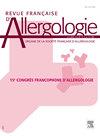Risk factors for severe food anaphylaxis: Data from the Allergy-Vigilance Network
IF 0.3
4区 医学
引用次数: 0
Abstract
Prérequis/Contexte
Having a better understanding of the risk factors of severe anaphylaxis is a crucial challenge for physicians.
Objectifs
This survey aimed to analyze food anaphylaxis cases and assess potential risk factors for severity.
Méthodes
We retrospectively analyzed severe food anaphylaxis cases recorded by the Allergy-Vigilance Network (2002–2021) and compared the main characteristics of grade 3 (Ring classification) to grade 4 cases to identify risk factors for severity using univariate/multivariate statistical analyses.
Résultats/Discussions
Of the 2621 food anaphylaxis cases, 731 (27.9%) were considered as severe (grade 3, n = 687 [94%] and grade 4, n = 44 [6%]), 56.1% were adults (mean age: 28.3 y [SD: 21.8]) and 53.7% were male. 19 deaths have been reported. In all, the most frequent triggers were peanut (13.9%), wheat (9.4%), cashew (5.8%), shrimp (5.3%) and cow's milk (4.6%). There were more grade 4 anaphylaxis cases in children than in adults (n = 26 versus n = 18, P = 0.01). In the univariate statistical analysis, individuals with a grade 4 anaphylaxis had more likely a history of allergy to the culprit food (71.1% versus 42.1%, P ˂ 0.001), a history of asthma (59.5% versus 30.4%, P ˂ 0.001), a peanut-induced anaphylaxis (34.1% versus 12.6%, P ˂ 0.001). In the multivariate analysis, individual with a grade 4 anaphylaxis had more likely a history of asthma (OR [95%CI]: 5.46 [2.02–14.73], P ˂ 0.001), peanut and cow's milk as culprit food triggers (OR: 4.94 [1.50–16.23], P = 0.009; OR: 6.44 [1.20–34.56], P = 0.03; respectively), convulsions as clinical anaphylaxis manifestation (OR: 24.81 [2.21–278.75], P = 0.009). Hives as clinical manifestation were more likely observed in individuals with a grade 3 anaphylaxis compared to grade 4 (OR: 0.18 [0.06–0.59], P = 0.004).
Conclusion
Our data highlight risk factors for severe food anaphylaxis including a history of asthma, peanut and cow's milk as anaphylaxis triggers. These individuals should benefit personalized management strategies.
严重食物过敏反应的危险因素:来自过敏症警戒网络的数据
对医生来说,更好地了解严重过敏反应的危险因素是一个至关重要的挑战。目的本调查旨在分析食物过敏病例,并评估其严重程度的潜在危险因素。我们回顾性分析了2002-2021年过敏-警戒网络记录的严重食物过敏反应病例,并比较了3级(Ring分类)和4级病例的主要特征,利用单变量/多变量统计分析确定严重程度的危险因素。2621例食物过敏反应中,重度731例(27.9%)(3级,n = 687[94%], 4级,n = 44[6%]),成人56.1%(平均年龄28.3岁[SD: 21.8]),男性53.7%。据报道,已有19人死亡。总的来说,最常见的诱发因素是花生(13.9%)、小麦(9.4%)、腰果(5.8%)、虾(5.3%)和牛奶(4.6%)。儿童发生4级过敏反应的病例多于成人(n = 26比n = 18, P = 0.01)。在单变量统计分析中,患有4级过敏反应的个体更有可能对罪魁祸首食物过敏(71.1%对42.1%,P小于0.001),哮喘史(59.5%对30.4%,P小于0.001),花生诱发的过敏反应(34.1%对12.6%,P小于0.001)。在多变量分析中,患有4级过敏反应的个体更有可能有哮喘史(OR [95%CI]: 5.46 [2.02-14.73], P小于0.001),花生和牛奶是罪魁祸首食物触发因素(OR: 4.94 [1.50-16.23], P = 0.009;Or: 6.44 [1.20-34.56], p = 0.03;惊厥为临床过敏反应表现(OR: 24.81 [2.21-278.75], P = 0.009)。与4级过敏反应患者相比,3级过敏反应患者更容易出现荨麻疹的临床表现(OR: 0.18 [0.06-0.59], P = 0.004)。结论:我们的数据突出了严重食物过敏反应的危险因素,包括哮喘史,花生和牛奶是过敏反应的触发因素。这些人应该受益于个性化的管理策略。
本文章由计算机程序翻译,如有差异,请以英文原文为准。
求助全文
约1分钟内获得全文
求助全文
来源期刊

Revue Francaise d Allergologie
Medicine-Immunology and Allergy
自引率
33.30%
发文量
349
期刊介绍:
La Revue Française d''Allergologie : un véritable forum pour faire connaître des travaux originaux et permettre la diffusion de l''information auprès de toutes les spécialités concernées par les pathologies allergiques. La Revue Française d''Allergologie (8 numéros par an) est au carrefour de nombreuses spécialités - dermatologie, pédiatrie, ORL, pneumologie, ophtalmologie, médecine interne - qui, toutes, ont à traiter des maladies allergiques. Les symptômes des allergies fondés sur des mécanismes communs sont le plus souvent associés et se succèdent chez un même patient. En forte progression depuis 20 ans, les maladies allergiques sont dans l''attente de perfectionnements et d''avancées thérapeutiques qui permettront aux nombreux patients qui en sont atteints de mieux vivre avec leurs allergies. La Revue Française d''Allergologie se veut donc un véritable forum de discussions et d''échanges entre tous les spécialistes confrontés aux pathologies
 求助内容:
求助内容: 应助结果提醒方式:
应助结果提醒方式:


